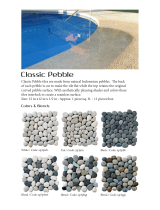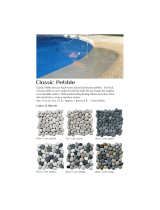
TILE SPECIFICATIONS
Developed by Nature Pebble 12 in. x 24 in.
tile shown in corridor horizontal pattern
Tile Specifications
STANDARDS &
REGULATIONS
TILE SPECIFICATIONS PAGE 1 OF 4
PORCELAIN/CERAMIC TEST RESULTS
Marazzi has always been proud to support solutions that better our industry. That’s why we’re among the first to
join the Tile Council of North America in testing our products with DCOF AcuTest
sm
, a new industry standard used to
measure dynamic coecient of friction (DCOF). DCOF AcuTest
sm
assesses a product’s suitability for the commercial
environment and the specific usability needs of the application.
A Measure of Friction
Friction is the force that resists the sliding motion of one surface against another. Contaminants, such as liquids,
can alter the measurement of friction. There are two types of friction: static (SCOF) and dynamic (DCOF). SCOF is
the ratio of forces necessary to start two surfaces sliding. This is what the former American Society for Testing and
Materials (ASTM) C1028 static test measured. DCOF is the ratio of forces necessary to keep two surfaces sliding.
Continually Pushing the Envelope
Marazzi, in partnership with the Tile Council of North America (TCNA), is proud to endorse the DCOF AcuTest
sm
because
it’s the most accurate method for determining whether or not a product is suitable for a commercial environment.
• Similar to measuring the speed of a car in both mph and kph, friction can also be measured on two scales
(DCOF and SCOF). The new 0.42 wet (DCOF) is replacing the old reference of 0.60 COF wet, which has long
been the benchmark for friction in commercial applications.
• The new, more stringent DCOF AcuTest
sm
uses a portable robot that, unlike ASTM C1028, gives realistic
values on very smooth surfaces.
While the industry standard is changing, the quality you can count on from us remains the same.
Water Absorption, ASTM C373-88
Water absorption is measured using ASTM C373-88. Individual tiles are weighed, saturated with water, then
weighed again. The percent dierence between the two conditions is referred to as the water absorption value.
Tiles are classified according to water absorption percentages as follows:
Impervious Tiles exhibiting 0.5% or less.
Vitreous Tiles exhibiting more than 0.5%, but not more than 3.0%.
Semi-Vitreous Tiles exhibiting more than 3.0%, but not more than 7.0%.
Non-Vitreous Tiles exhibiting more than 7.0%.
Scratch Hardness – Mohs Scale Ratings
The relative hardness of glazed tile is an important issue that should be addressed when selecting a tile. The test is
performed by scratching the surface of the tile with dierent minerals and subjectively assigning a “Mohs Scale of
Mineral Hardness” number to the glaze. The softest mineral used is talc (“1” rating)—the hardest is a diamond (“10”
rating). Other minerals of varying hardness providing Mohs Scale of Mineral Hardness values of 5 or more are suitable
for most residential floor applications. A value of 7 or greater is normally recommended for commercial applications.
Breaking Strength Ceramic Tile, ASTM C648-04
Ceramic tiles used on floors and walls must be able to withstand the expected load bearing capacity of various

TILE SPECIFICATIONS
Developed by Nature Pebble 12 in. x 24 in.
tile shown in corridor horizontal pattern
Tile Specifications
STANDARDS &
REGULATIONS
TILE SPECIFICATIONS PAGE 2 OF 4
installations. The tile industry uses ASTM C648-04 to determine the strength and durability of the tile. A force is
applied to an unsupported portion of the tile specimen until breakage occurs. The ultimate breaking strength is
then recorded in pounds. Final selection of the tile should be based upon the breaking strength and the appropriate
installation method. Tile integrity is critically dependent upon proper installation. Marazzi recommends strict
adherence to industry installation guidelines set forth in ANSI A108, A118 and A136.
Chemical Resistance, ASTM C650-04
Chemical resistance is measured using ASTM C650-04. A tile sample is placed in continuous contact with a variety
of chemicals for 24 hours, rinsing the surface and then examining the surface for visible variation.
Shade Variations
Tiles range from complete consistency to a more random appearance.
Here’s an overview of color and shading of individual tile selections:
Shade variation V0 Monochromatic appearance
Pieces of the same shade value are very uniform and
smooth in texture.
Shade variation V1 Low variation
Dierences among pieces from the same production run
are minimal.
Shade variation V2 Medium variation
Clearly distinguishable dierences in texture and/or
pattern within similar colors.
Shade variation V3 High variation
While the colors and/or texture present on a single piece
of tile will be indicative of the color and/or texture to be
expected on the other tiles, the amount of color and/
or texture on each piece may vary significantly. It is
recommended that the entire range be viewed before
selection.
Shade variation V4 Random variation
Random color and/or texture dierences from tile to
tile, so that one tile may have totally dierent colors
and/or textures from that on other tiles. Thus, the final
installation will be unique. It is recommended that the
entire range be viewed before selection.
Frost Resistance
Industry criteria dictate that tile shall not exceed 5% water absorption to be recognized as frost resistant. To be
recognized as Porcelain tile, the water absorption rate cannot exceed 0.50% (impervious). Wall tile must not exceed
20% water absorption and is not frost resistant.

TILE SPECIFICATIONS
Developed by Nature Pebble 12 in. x 24 in.
tile shown in corridor horizontal pattern
Tile Specifications
STANDARDS &
REGULATIONS
TILE SPECIFICATIONS PAGE 3 OF 4
Abrasion Resistance, ASTM C1027-99
The durability of glazed tile is measured subjectively by observing the visible surface abrasion of the tile when
subjected to the ASTM C1027-99 testing procedure. Marazzi evaluates glazed tile recommended for floor
applications using this test method which includes the following classification system:
CLASS ONE
Tile in this class may withstand soft-soled foot trac, provided that dirt and/or other abrasives are not
present on the wear surface. Class I tile should not be used in areas with direct access to the outside or large
amounts of foot trac. See Frost Resistance for installation-specific details.
CLASS TWO
Tile in this class may withstand soft-soled and some normal foot trac provided the dirt and/or other
abrasives are kept to a minimum. Class II tile should not be used in areas with direct access to the outside,
large amounts of foot trac, or areas exposed to abnormal footwear. See Coecient of Friction and Frost
Resistance for installation-specific details.
CLASS THREE
Tile in this class may withstand normal footwear and regular trac, with some dirt and/or other abrasives
present in limited quantities. Tile in this class may be used in light commercial installations with limited foot
trac and with no direct access to the outside including residential kitchens and hallways, with limited trac
from the outside. See Coecient of Friction and Frost Resistance for installation-specific details.
CLASS FOUR
Tile in this class may withstand heavier amounts of trac with greater amounts of dirt and/or other abrasives
present including commercial kitchens and areas with regular trac from the outside. See Coecient of Friction
and Frost Resistance for installation-specific details.
CLASS FIVE
Tile in this class may withstand constant foot trac with larger amounts of dirt and/or other abrasives
including airports, malls, and other commercial walkways subject to high volumes of foot trac and constant
trac from the outside. See Coecient of Friction and Frost Resistance for installation-specific details.
Coecient of Friction, DCOF Wet Areas (Minimum 0.42)
Water, oil, grease or other fluids create slippery conditions. When installing floors in areas with exposure to these
conditions, a minimum DCOF value of 0.42 is required. Additionally, extra caution is required with regards to product
selection and proper maintenance. Visit www.tcnatile.com for complete information regarding the DCOF Acutest
sm
test method and values.

TILE SPECIFICATIONS
Developed by Nature Pebble 12 in. x 24 in.
tile shown in corridor horizontal pattern
Tile Specifications
STANDARDS &
REGULATIONS
TILE SPECIFICATIONS PAGE 4 OF 4
Industry Standards
The American Society for Testing and Materials (ASTM) and the American National Standards Institute (ANSI) are
nationally recognized organizations, which identify and develop industry test methods and technical standards.
Neither ASTM nor ANSI establish an industry standard identifying a minimum COF value whereby ceramic tile may
be labeled “slip resistant”. All Standard Grade ceramic tile products manufactured by or for Marazzi meet or exceed
the requirements of ANSI A137.1. See product pages for series-specific technical data.
-
 1
1
-
 2
2
-
 3
3
-
 4
4
Ask a question and I''ll find the answer in the document
Finding information in a document is now easier with AI
Related papers
Other documents
-
Harbor Freight Tools Flooring 95742 User manual
-
Merola Tile FKOLTRG2 User manual
-
 Cruz Bay xp3pgo Specification
Cruz Bay xp3pgo Specification
-
 Cruz Bay xp3pabk Specification
Cruz Bay xp3pabk Specification
-
Rain Forest PTS-HNTAN User manual
-
ELIANE 8026980 Installation guide
-
daltile CC071818HD1PV Operating instructions
-
Megatrade 26 Specification
-
daltile K711SCRL44491P1 User manual
-
Unbranded 1135089 Specification





